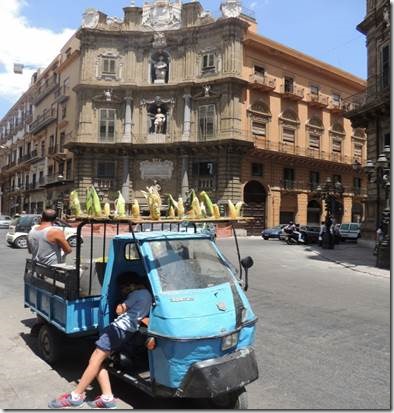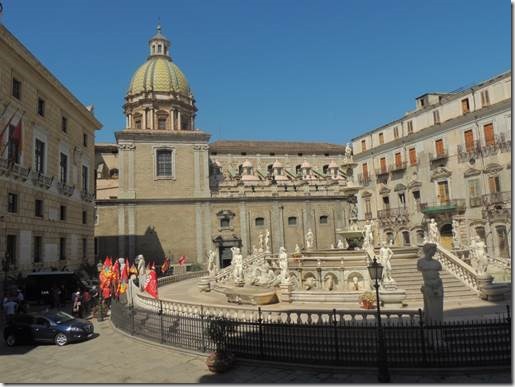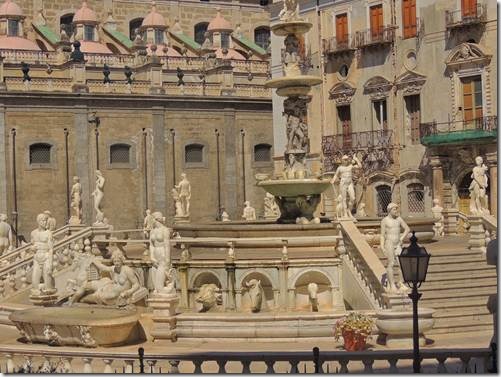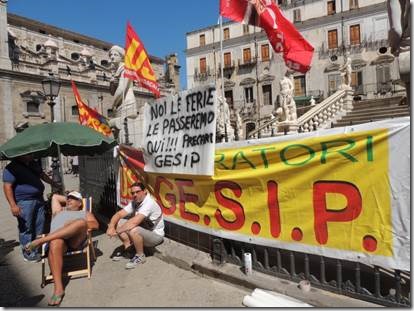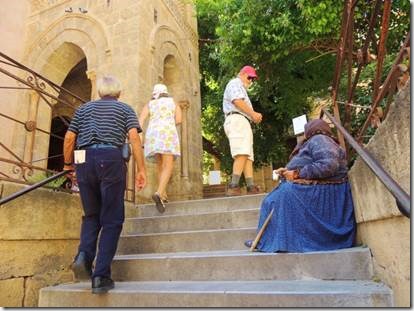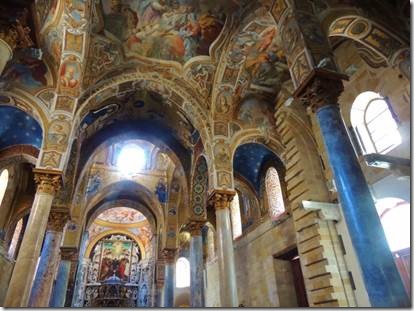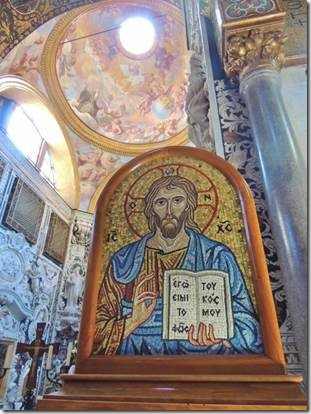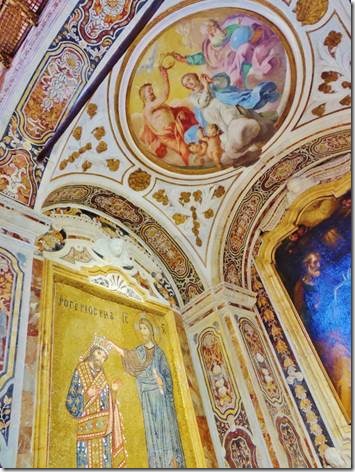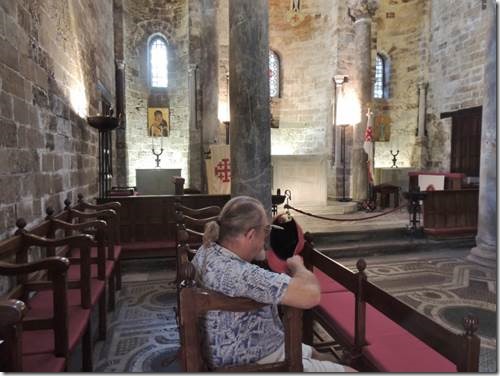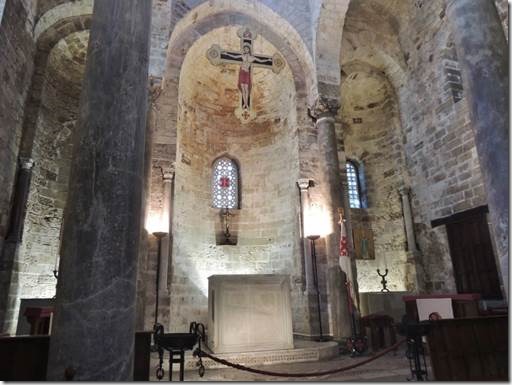Asalam Alaykum,
We are as far north as you can be and still be in Africa. But I’ve never been to Africa before so this counts. Funny enough though, last night was the first rain we’ve seen since before we left Turkey apparently surprising everyone here too. There’s a British couple who’ve been here 7 years and they’re helping us with good info. Makes everything about a new place easier when there’s someone there to show you the ropes.
But for this email we’re back in Sicily in Palermo.
Ru
Four Corners, The fountain and two churches next door.
Plan A our second morning was to spend some hours at the Archeological Museum, number 1 on Linda and Frank’s list of things to see in Palermo. We actually walked right past it on the Via Roma because its entire front was surrounded with scaffolding and huge billboards. All of that was due to the renovations underway, not to be done any time soon that day, week or month. So we moved along to plan B, more of the Literary Walking tour: the Four Corners, The Fountain and two more churches.
“Via Maqueda, just beyond the Piazza Pretoria, intersects the CORSO at the renowned landmark QUATRO CANTI, and operatic crossroads with 4 facades bearing fountains and statues of the 4 seasons, the 4 Spanish kings, and the 4 patronesses of Palermo…” Desiring Italy
“Description: The "Quattro Canti" (Four Corners) is the traditional center of Palermo, the crossroad marking the heart of Palermo’s old historic district. Many of Palermo’s monuments, artistic churches and other sights of historical and touristic interest are located within walking distance of the Quattro Canti. Although almost everyone in Palermo calls the Four Corners "Quattro Canti", the intersection’s official name is actually "Piazza Vigilena," named for the Spanish Viceroy who had the sculptures built on the Four Corners back in 1611. Each of the four buildings that comprise the Quattro Canti, has three levels covered with Baroque sculptures that were designed by the architect Giulio Lasso. The sculptures on the facades of the four buildings illustrate various themes: the Four Seasons, Spanish kings and various patron saints of Palermo’s four old quarters.
The fountains at ground level are typically Baroque. These sculptures were actually executed by a collective of talented local sculptors of that era, among whom d’Aprile, La Mattina and Tedeschi. Thanks to years of exposure to smog and soot, the once pearl colored sculptures have been transformed into a grimy gray that has obscured some of their definition but none of their magnificence.”
Date built: 1608 http://www.fountainsoc.org.uk/fountain/73
The "Quattro Canti"
The “Quattro Canti” is the junction in Palermo. Effectively, it is the centre point of the four areas of the old town centre. You will almost inevitably pass through it and it is worth stopping for five minutes to have a look at its sculptures which were commissioned by the Spanish Viceroy in 1611. The sculptures on each of the four corners depict a variety of themes, including the four seasons, four Spanish kings and the four patron saints of the old town areas. http://www.thinksicily.com/
|
There was lots of traffic, human, horse, motorcycle and car, so no remote chance of standing in the center and taking photos all the way round. It was hard to find standing still space on the sidewalk. Some horses had blue, some white and some pink ear coverings. |
|
Selling corn on the corner. This would be a hit at RAGBRAI, the huge bike ride across Iowa where 10,000+ bicycle riders are always looking for snacks. |
|
Early evening the corners were calmer. |
|
B & W shot of one of the 4 corners. The church dome at the fountain was visible from just the right angle. |
From the Four Corners we walked along to the Piazza Pretoria.
“Going south-east down Via Maqueda you will come across Piazza Pretoria which is home not only to a splendid fountain but several other impressive buildings including, on the right, the City Hall. The fountain, known for generations as the “Fountain of Shame”, has an interesting history. It was originally built in 1555 by the Florentine sculpture Francesco Camiliani for a Tuscan villa owned by the Viceroy Pedro de Toledo. His son, on inheriting the villa in 1574, thought it a little too risqué for his tastes and sold it to the City of Palermo who erected it where it now stands. The large central fountain is the focal point for sixteen nude statues of nymphs, humans, mermaids and satyrs. If you imagine this being erected during the Inquisition, it is quite easy to imagine why it received its epithet, the “Fountain of Shame”.
|
A “laid back” demonstration about something in front of the City Hall across from the fountain. |
Around the back of the fountain and City Hall were the Churches of Santa Maria dell’Ammiraglio and San Cataldo, two very different churches.
“The Church of Santa Maria dell’Ammiraglio (La Martorana)
Behind the City Hall, there is another square, Piazza Bellini where you can see two of Palermo’s most interesting churches: the Church of Santa Maria dell’Ammiraglio (more commonly known as La Martorana) and the Church of San Cataldo, instantly recognizeable thanks to its trio of red domes. La Martorana was commissioned in 1143 by George of Antioch, a famous Admiral (a word of Arabic origin) of the fleet of King Roger II. Initially the church was dedicated to the celebration of Greek Orthodox rites but this changed in the 13th century when it became part of the Catholic Church. Several parts of the structure were unfortunately changed during the 17th century and many of the original mosaics were discarded to make way for Baroque frescoes. However, the surviving mosaics are amongst the most impressive ever to have been created in Sicily. Indeed, the craftsmen who were brought from Byzantium by King Roger II to work on the Normal Palace and the Duomo at Cefalu’, also contributed their art to this church. The wonderful bell tower outside is the apogee of Norman-Arab architecture.”
“The Chiesa della Martorana in Palermo dates from 1143 and is famed for its spectacular mosaics. Its official name is Santa Maria dell’Ammiraglio but it is better known as La Martorana.
The church was founded in 1143 by George of Antioch, the admiral of the Norman King Roger. Dedicated to the Virgin Mary, it became known as Santa Maria dell’Ammiraglio, "St. Mary of the Admiral." The church’s more common name comes from Eloisa Martorana, who founded a nearby Benedictine convent in 1194.
The church has seen its share of history over the years: it was in La Martorana that Sicily’s noblemen convened to offer the crown to Peter of Aragon. The facade and interior were altered considerably in 1588, during the baroque period, but thankfully the glorious mosaics survive intact and on full display.
The graceful Norman bell tower is original from the 12th century. The facade, on the other hand, is a baroque renovation of the original Norman front. Entrance is through a beautiful portico with a trio of ancient columns and double arch openings.
Glittering Norman-Byzantine mosaics from c.1150 cover the interior, including on and around the columns that hold up the principal cupola. The mosaics were overseen by George of Antioch himself, who was of Greek descent and loved the Byzantine mosaics of his homeland. Scholars think the craftsmen who designed these mosaics also did the mosaic work in the Cappella Palatina.
Even after 850 years, the colors remain vibrant: the golden background is pierced with streaks of spring green, ivory, azure blue, and red. High along the western wall is some of the oldest and best-preserved mosaic artwork of the Norman period. Just inside the entrance is an interesting mosaic of King Roger II being crowned by Christ. Roger is dressed in a jeweled Byzantine stole, reflecting the Norman court’s penchant for all things Byzantine. Archangels along the ceiling wear the same stole.”
http://www.sacred-destinations.com/italy/palermo-martorana
|
The Church of Santa Maria dell’Ammiraglio (La Martorana) and The Church of San Cataldo |
|
Randal put a few coins in her cup. |
|
A noticeable mix of artistic styles…Byzantine and Baroque |
|
According to my Sicily book this is a 12th century mosaic of Roger II being crowned by Christ |
Next door the red dome topped very austere church.
The Church of San Cataldo
“Standing next to La Martorana is the miniscule Church of San Cataldo, characterised by its three red domes. It was built in 1154 and has retained its original ascetic atmosphere perfectly. The only decoration to speak of is the original mosaic floor. It is presently the religious seat of the Knights of the Holy Sepulchre in Palermo.”
La Cataldo, Palermo
Known for its distinctive red domes, the small Chiesa di San Cataldo is a 12th-century Norman church stands next door to La Martorana in Palermo, Sicily.
The church of San Cataldo was founded by Maio of Bari, chancellor to William I, during the Norman occupation in 1154. After Maio died in 1160, the interior was never completed. The church has belonged to the Knights of the Holy Sepulchre since 1937. The exterior of this small church looks like a squat stone box with small arched openings. It is topped by its most striking feature: a row of three Saracen-style, bulbous, red "golfball" domes.
The austere stone interior, with bare walls and three petite stone cupolas over the nave, evokes a strong sense of the Middle Ages. Aside from the carved capitals, the only decoration is the fine mosaic tilework on the floor. http://www.sacred-destinations.com/italy/palermo-cataldo
|
The very unadorned domed ceiling. |



